Treatment with the help of the patient’s own information
in the BICOM® mobile VET bioresonance device
In contrast to other “frequency therapy devices”, BICOM® bioresonance is a method that is highly individual and perfectly tailored to the needs of the patient through the use of the patient’s own information and the possibility of testing specific wave patterns for resonance.
The patient’s own pathological and physiological information is recorded using special applicators and fed into the BICOM® mobile VET.
Depending on the therapy program, the specific wave pattern as a carrier of information is amplified, weakened or inverted and transmitted back to the patient in modulated form, which means that the transmission of information changes in clarity depending on the modulation or it disappears completely.
The treatment signals continuously adapt to the changing pathological situation of the patient. As the therapy progresses, the body’s ability to regulate is reactivated.
Find out more about this topic at our regular events. Together with veterinarians and animal naturopaths, we offer various face-to-face and online events .
The BICOM® bioresonance method is a cause-oriented, holistic treatment concept. It can narrow down the cause of the health problem in animals and find out even the hidden causes of the clinical picture.
Animals have a natural regulatory system that can also compensate for unusual influences. However, even good self-healing powers eventually reach their limits. Persistent exposure to allergens, environmental toxins, fungi, viruses, bacteria or stress and changed living conditions weaken the immune system and are often the cause of an illness. In particular, fungal infestation on the skin or chronic diseases in general are not always due to a breeding-related genetic defect, but are signs of a disturbed immune system.
The BICOM® bioresonance method is the key to successful diagnosis and therapy, especially for animals that cannot tell us exactly where it hurts or what the symptoms are. It is a gentle form of therapy that can be carried out without side effects and without additional stress for the animal.
The BICOM® mobile VET records the bioenergetic state of the animal, processes the information it contains and returns modified vibrations / therapy frequency patterns to the animal. Symptoms and stress can be diagnosed and targeted therapy can be initiated.
Through the use of endogenous and exogenous substances, the body’s own self-healing powers can be activated and imbalances that have existed for a long time can also be regulated.
REGUMED Medizintechnik are pioneers of the BICOM® bioresonance method. More than 30,000 therapists worldwide, well over 10,000 of them in Germany, successfully use their therapy concept.
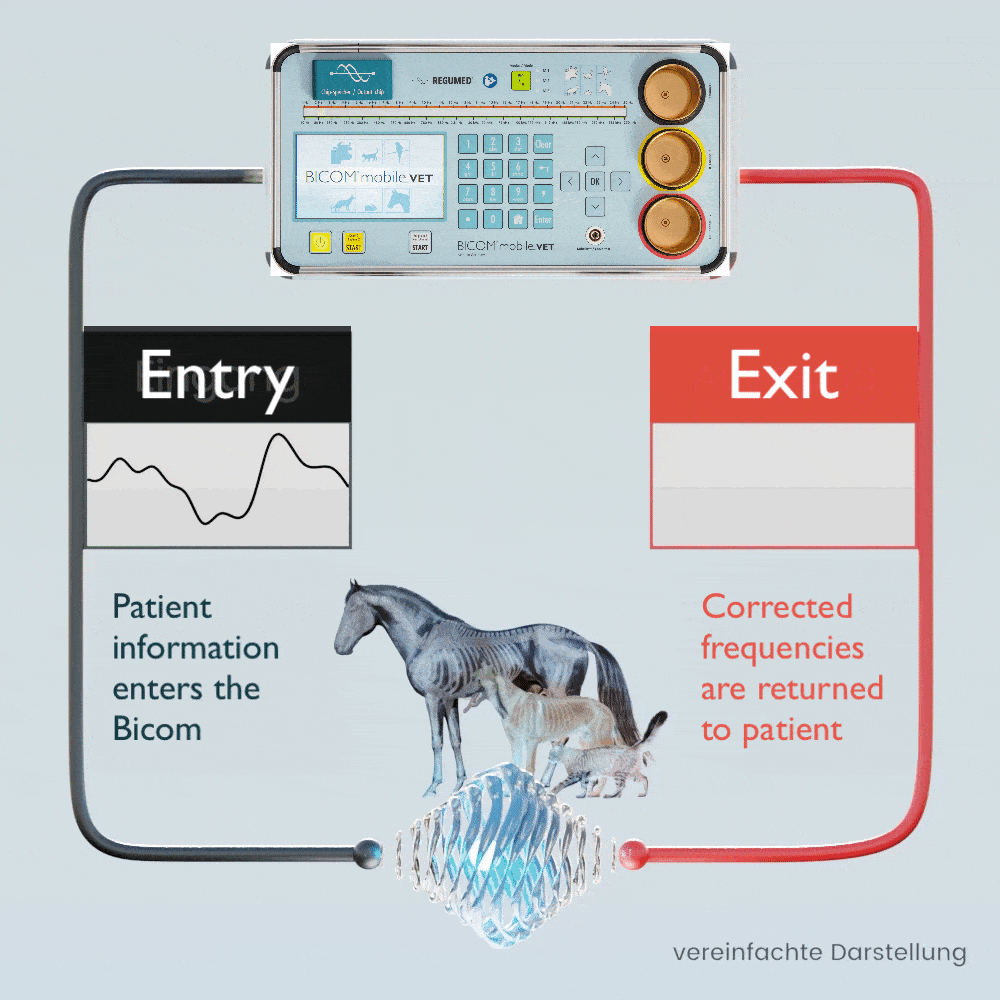
Biophysical basics of the bioresonance method
Life is only possible when three conditions are met: matter, energy and information.
We also find these aspects in conventional medicine, both in diagnostics and in therapy. For example, every drug is also a carrier of information.
Information is neither energy nor matter, it is immaterial and comparable to the meaning of a message from a sending to a receiving system.
In addition to the electrical processes in the receptor proteins and biomembranes in general, electromagnetic interactions through light (biophotons) also play a role in cell communication and the transmission of information.
Specific electromagnetic wave patterns act as information carriers. These wave patterns can be modulated by the BICOM® device in order to eliminate disturbing or stressful information in an organism.
The goal is to restore the free flow of healing information (cell communication) and thus support the self-regulation of the organism and the self-healing powers.
Individual, patient-specific information or information from native substances, digitized substances or information stored on storage media can be used for therapy.
What your colleagues are saying…
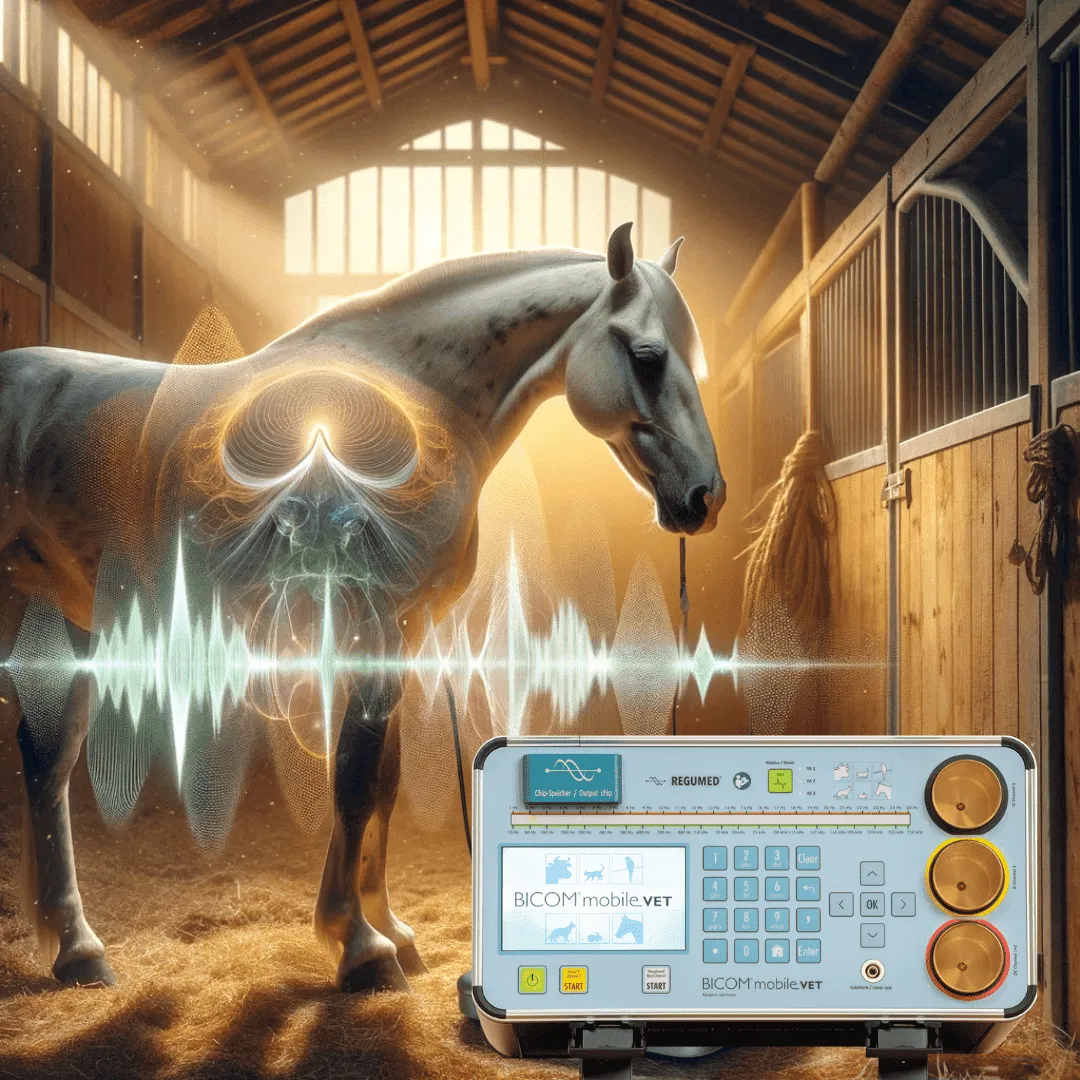
Colic in horses: Part 1 (energetic diagnosis)
Custom HTML/CSS/JAVASCRIPT
Colic is a collective term for diseases in the horse’s gastrointestinal tract. There are different forms, with different symptoms and causes. It usually involves flatulence, cramps, constipation and even intestinal blockages or intestinal obstruction. Colic can become a life-threatening emergency and requires immediate veterinary attention.
A distinction is made between different types of colic:
Spastic colic: caused by stress, feeding errors, poorly chewed food or worm infestation. These colics can resolve spontaneously or with medication, but can also turn into constipation (see below).
Gas colic: caused by flatulent feedstuffs such as clover, grass cuttings, beetroot, soft bread, maize, potatoes or by feedstuffs that are infested with fungi and/or bacteria. These colics can also lead to constipation (see below).
Sand colic: caused by sand deposits in the large intestine due to increased ingestion of sand in heavily grazed pastures or sand This can also lead to blockages.
Large intestine blockages: often caused by housing or feeding errors (too much straw, too little water and exercise, overeating, poor chewing). Constipations in the large intestine are usually milder in symptoms and can last for several days.
– Blockages in the small intestine: due to wrong feed (grass clippings) or due to bottlenecks in the intestine, sometimes also due to roundworms. In this case, surgery may be necessary.
Stomach overload: caused by too much swelling or fermenting food (primary stomach overload) or by a backlog of food residues, saliva and secretions from the small intestine leading to intestinal obstruction (secondary stomach overload). This is a life-threatening emergency with severe pain, respiratory and circulatory
Intestinal obstruction: Inactivity of the intestinal muscles leads to spasm or paralysis of the intestine, or obstruction by local obstructions (e.g. tumours) or suspension from the splenic-kidney ligament. Intestinal obstruction may also occur (e.g.: in stallions in the scrotum or other hernial cavities).
Intestinal twisting/entanglement: intestinal entanglement can occur due to feeding errors (faulty fermentation, gas or cramp colic),
where one part of the intestine rises up and another part sinks down due to overloading. When rolling or running, the intestine can then become
Colic symptoms:
Restlessness, pawing, looking at the abdomen or kicking under the
Frequent rolling, repeated lying down and standing up, reluctance to walk,
frequent bleating, sitting like a
Profuse sweating, circulatory and respiratory problems
Cramped abdominal muscles, refusal to eat, increased or decreased intestinal sounds or decreased bowel sounds
In the case of colic, the veterinarian must be informed immediately, who, depending on the severity of the illness and the type of colic, will apply appropriate treatment methods of a medicinal nature, partly through a naso-pharyngeal probe or rectally, or, in an emergency, will perform surgery.
In this acute condition, a detailed energetic diagnosis with the BICOM is not indicated. It is a real emergency and rapid action is required.
Until the vet arrives, therapies can still be carried out with the bioresonance method. Also a subsequent follow-up treatment or interval treatments for horses that tend to colic more often can be treated well with the bioresonance method. We will report on these therapeutic possibilities in the next newsletter.
This is followed by the testing of energetic blockages such as
Vertebral blockages, jaw joint, scars,
blockages caused by geopathic and radiation
and also blockages caused by vaccinations or
vaccinations or medication,
the metabolism or the acid/base
Testing of the KTT – test set 5 elements:
The large intestine is assigned to the element metal, therefore a resonance is usually found here during testing. But also the element earth can go into resonance, because the stomach, spleen and pancreas are assigned to this element and metabolic problems are often found here.
Testing programme ð 192.0 or 198.0. Input cup / tapping applicator ð Test ampoule only
Further triggering factors are to be tested with the help of the test sets from KTT and / or ETT:
Nutrition: Feed intolerances, (KTT – test kit: “Horses Special ” and “ETT – Basis C & D Veterinary”)
Environmental factors/chemical stress: Pseudo-allergy due to E-substances in feed (flavour enhancers, sweeteners, preservatives ), insecticides, pesticides, fungicides etc. in the food or environment.
(KTT – test set: “E – Substances” and “Parasites/Environmental Pollutants”).
Stress: due to lack of exercise, improper housing conditions,
Pre-existing diseases: Infections or stressful information due to parasites, bacteria, fungi or viruses, worm infestation or worming
(KTT – Test set: “Bacteria”, “Viruses/Fungi” and “Parasites/Environmental Burdens” and / or ETT – Basis D Veterinary”)
Hormonal disorders: Disturbances of the hormonal balance, e.g. in the pancreas, thyroid or pituitary/hypothalamus.
(KTT – Test set: “Hormones, organs, neurotransmitters, hereditary toxins” as well as the “ETT – Pancreas Set”)
Then, based on the blockages and stressful information found, a therapeutic regimen is put together and the owner is given appropriate nutritional recommendations for the animal patient. With the tested ampoules sensible combinations for an efficient therapy.
In addition to the energetic testing with the tensor on the animal-patient, BICOM programmes,
e.g. organs of elimination (liver, kidney, lymph, intestine, lung, etc.) can also be tested for an approval / resonance in order to treat them afterwards.
Through the Academy for Complementary and Informational Medicine, further training courses are regularly organised, also on these topics:
Seminar “Tensor testing”
Seminar “TCM – Nutrition and 5 Elements for the Bioresonance Method”
Seminar “Combined Test Technique (KTT) in Human and Veterinary Medicine”
Seminar “Treatment of the most common diseases of horses”
Treatment Priorities
For gentle and optimal treatment of the causes of diseases in animals
The BICOM® bioresonance method is predestined for use with large and farm animals such as horses , but also with dogs , cats and small animals. The treatment focus of the BICOM® mobile VET is wide-ranging. It is now used for many indications.
It recognises health deficits at an early stage and is used, among other things, for the following symptoms:
sweet itch
Feed intolerances
allergies and related diseases
COB/COPD
leishmaniasis
Lyme disease
anaplasmosis
lameness in horses
hoof ulcer
Poisoning by poisoned baits, plants etc.
mauke
Feline infectious peritonitis (FIP)
Cat flu/cat disease
eye/conjunctivitis
and much more
Get advice now!
Our experts are happy to be there for you personally
Our BICOM® bioresonance experts are available to answer any questions you may have
and will be happy to advise you personally and individually.

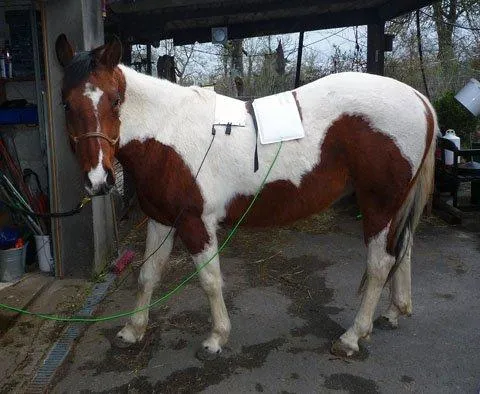

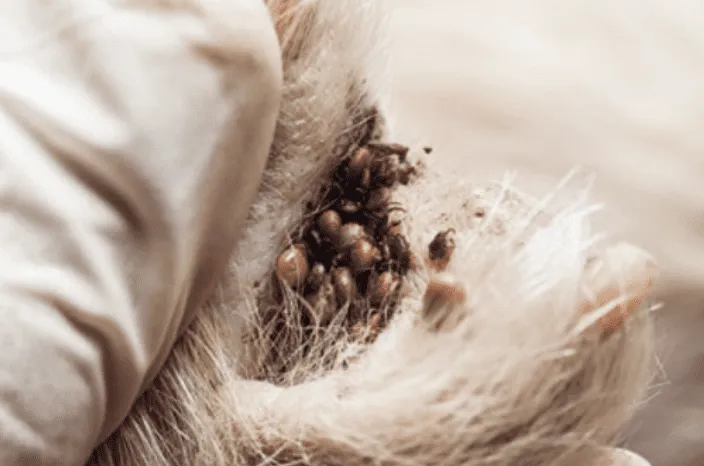
Request more information
Quick Links
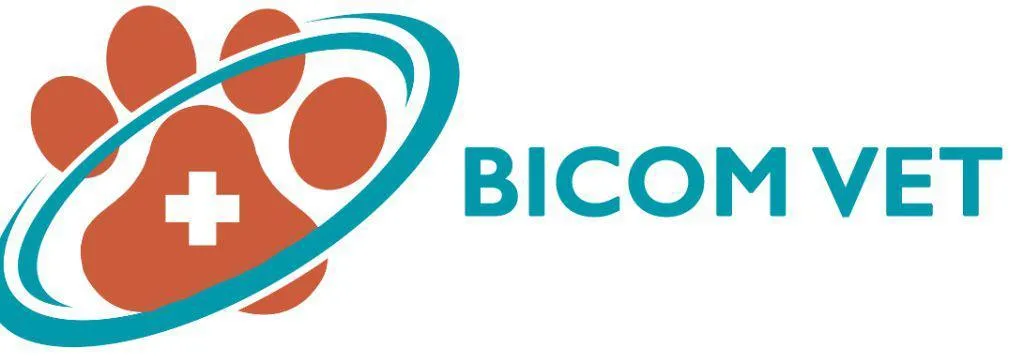
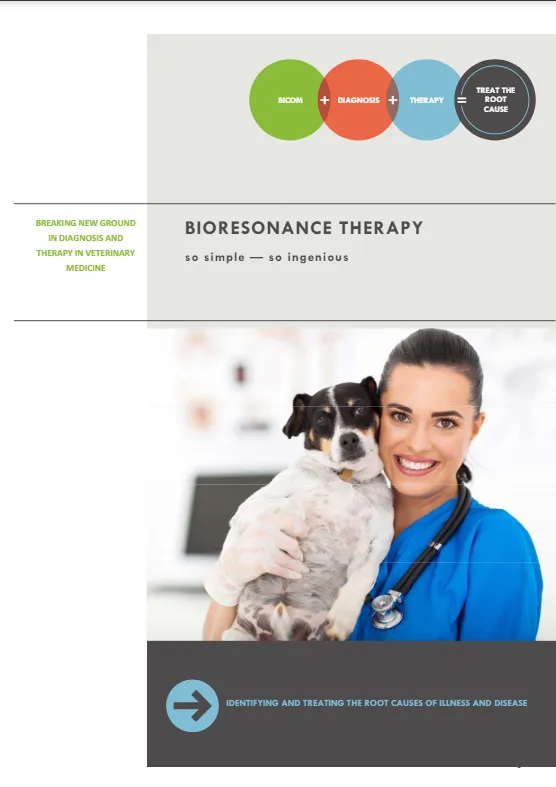



Facebook
Instagram
Mail